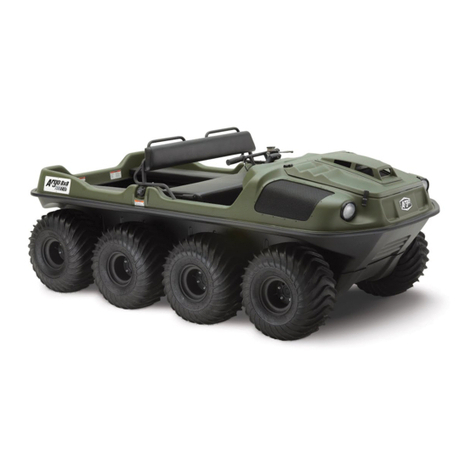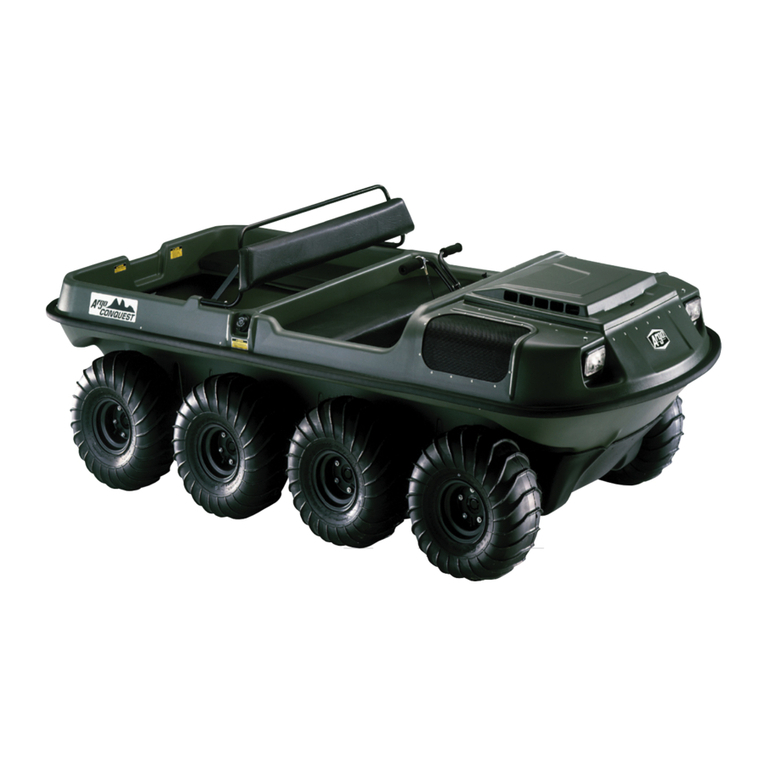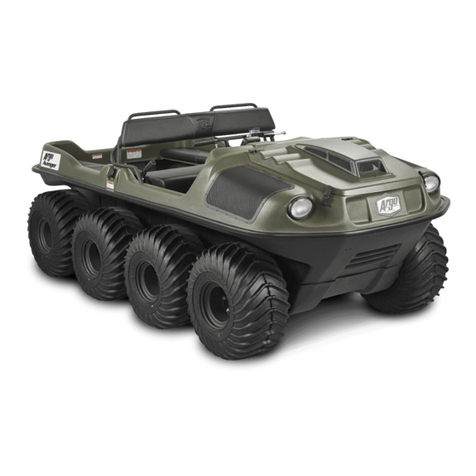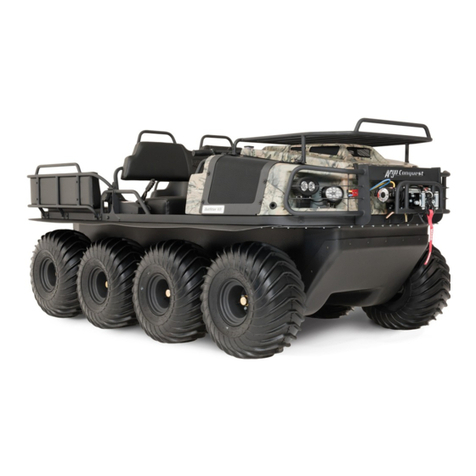
2
SECTION 1
GENERAL INFORMATION
Carefullyobservethe maximum load capacity for your vehicle
on land and in water as listed in the following:
8x8AVENGER700(V)
Engine: Kohler 674 cc (26 h.p.) V-twin 4 cycle, liquid cooled
Transmission: 2 forward speeds, neutral and reverse
Clutch: Variable speed torque converter
Fuel Capacity: 27 Litre (5.9 Imp. Ga., 7.1 U.S Gal.)
Steering/Brakes: Hydraulic Caliper, 10.25" disc with holding brake
system
Drive Chains: Double RC-50 roller chains & Single RC 60 Roller
chain
Electrical: 12 volt D.C. battery, 435 cranking amps at 0 F;
25 Amp charging system, electronic ignition
Speed: Land - 32 km/hr (20 mph)*
Water - 4 km/h (2.5 mph)
Load Capacity: Land - 6 persons or 522kg (1150lbs)
SEE SECT.1.4.1Water - 4 adults or 454kg (1000lbs)
Tires: 25x11.5-9NHS, 2 ply
Dry Weight: 567kg (1250lbs)
8x8AVENGER750EFI(H)
Engine: Kohler 747 cc (31 h.p.) V-twin 4 cycle, liquid cooled
Transmission: 2 forward speeds, neutral and reverse
Clutch: Variable speed torque converter
Fuel Capacity: 27 Litre (5.9 Imp. Ga., 7.1 U.S Gal.)
Steering/Brakes: Hydraulic Caliper, 10.25" disc with holding brake
system
Drive Chains: Double RC-50 roller chains & Single RC 60 Roller
chain
Electrical: 12 volt D.C. battery, 435 cranking amps at 0 F;
25 Amp charging system, electronic ignition
Speed: Land - 32 km/hr (20 mph)*
Water - 4 km/h (2.5 mph)
Load Capacity: Land - 6 persons or 522kg (1150lbs)
SEE SECT.1.4.1Water - 4 adults or 454kg (1000lbs)
Tires: 25x11.5-9NHS, 2 ply
Dry Weight: 567kg (1250lbs)
8x8FRONTIER650(J)
Engine: Briggs & Stratton Vanguard, 627 cc cooler cleaner
running (23 h.p.) V-Twin, 4 cycle, air cooled
Transmission: 2 forward speeds, neutral and reverse
Clutch: Variable speed torque converter
Fuel Capacity: 27 Litre (5.9 Imp. Ga., 7.1 U.S Gal.)
Steering/Brakes: Hydraulic Caliper, 10.25" disc with holding brake
system
Drive Chains: Double RC-50 roller chains & Single RC 60 Roller
chain
Electrical: 12 volt D.C. battery, 435 cranking amps at 0 F;
20/50 Amp magneto type charging system,
electronic ignition
Speed: Land - 30 km/h (19 mph)*
Water - 4 km/h (2.5 mph)
Load Capacity: Land - 6 persons or 454 kg (1000 lbs.)
SEE SECT.1.4.1Water - 4 adults or 408 kg (900 lbs.)
Tires: 24x10.00-8NHS, 4 ply
Dry Weight: 476 kg (1050 lbs.)
6x6FRONTIER650(F)
Engine: Briggs & Stratton Vanguard, 627 cc cooler cleaner
running (23 h.p.) V-Twin, 4 cycle, air cooled
Transmission: 2 forward speeds, neutral and reverse
Clutch: Variable speed torque converter
Fuel Capacity: 27 Litre (5.9 Imp. Ga., 7.1 U.S Gal.)
Steering/Brakes: Hydraulic Caliper, 10.25" disc with holding brake
system
Drive Chains: Single RC-60 roller chain
Electrical: 12 volt D.C. battery, 435 cranking amps at 0 F;
20/50 Amp magneto type charging system,
electronic ignition
Speed: Land - 35 km/h (22 mph)*
Water - 5 km/h (3.5 mph)
Load Capacity: Land - 4 persons or 317 kg (700 lbs.)
SEE SECT.1.4.1Water - 2 adults or 227 kg (500 lbs.)
Tires: 24x10.00-8NHS, 8 ply
Dry Weight: 404 kg (890 lbs.)
6x6FRONTIER580(M)
Engine: Briggs & Stratton Vanguard, 570 cc cooler cleaner
running (18 h.p.) V-Twin, 4 cycle, air cooled
Transmission: 2 forward speeds, neutral and reverse
Clutch: Variable speed torque converter
Fuel Capacity: 27 Litre (5.9 Imp. Ga., 7.1 U.S Gal.)
Steering/Brakes: Hydraulic Caliper, 10.25" disc with holding brake
system
Drive Chains: Single RC-60 roller chain
Electrical: 12 volt D.C. battery, 435 cranking amps at 0 F;
20/50 Amp magneto type charging system,
electronic ignition
Speed: Land - 35 km/h (22 mph)*
Water - 5 km/h (3.5 mph)
Load Capacity: Land - 4 persons or 317 kg (700 lbs.)
SEE SECT.1.4.1Water - 2 adults or 227 kg (500 lbs.)
Tires: 24x10.00-8NHS, 4 ply
Dry Weight: 386 kg (850 lbs.)
6x6FRONTIER480(L)
Engine: Briggs & Stratton Vanguard, 480 cc, V-Twin, 4 cycle,
air cooled
Transmission: 2 forward speeds, neutral and reverse
Clutch: Variable speed torque converter
Fuel Capacity: 27 Litre (5.9 Imp. Ga., 7.1 U.S Gal.)
Steering/Brakes: Hydraulic Caliper, 10.25" disc with holding brake
system
Drive Chains: Single RC-60 roller chain
Electrical: 12 volt D.C. battery, 435 cranking amps at 0 F;
20 Amp magneto type charging system, electronic
ignition
Speed: Land - 35 km/h (22 mph)*
Water - 5 km/h (3.5 mph)
Load Capacity: Land - 4 persons or 317 kg (700 lbs.)
SEE SECT.1.4.1Water - 2 adults or 227 kg (500 lbs.)
Tires: 24x10.00-8NHS, 4 ply
Dry Weight: 386 kg (850 lbs.)
* Speed is 20% less with 34-100-3.3 transmission

































